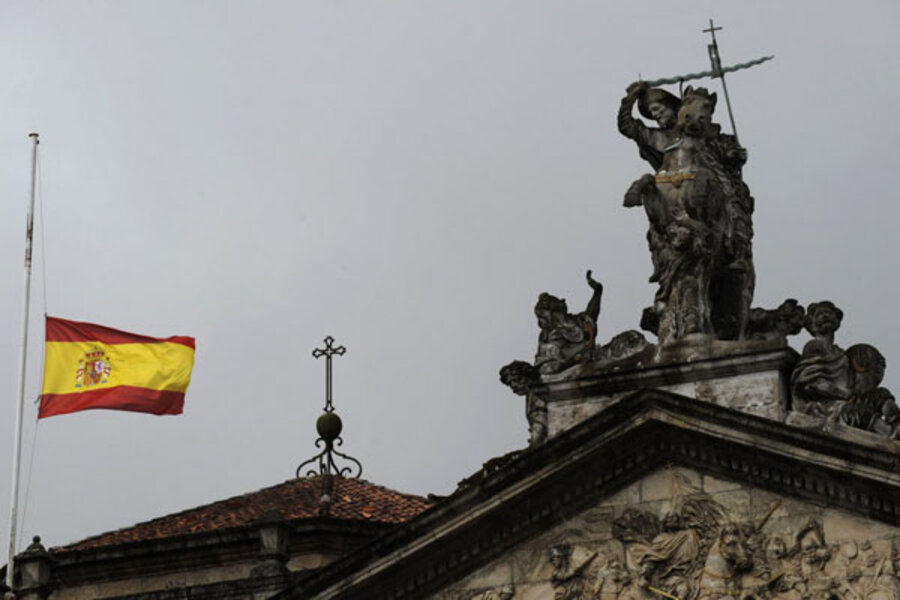Questions about Spain train crash go beyond driver
Loading...
| Madrid
Spanish officials are blaming speeding for the derailment of a high-speed passenger train that killed scores of people this week, and more specifically the driver, who has been taken into police custody "in connection with recklessness."
"The driver is under custody because what doubt is there that there are rational indications to think that he may be held accountable eventually for what happened," said Saturday Spanish Intetior Minister Jorge Fernández-Díaz in Santiago.
Despite the anger being directed at the driver and the train's apparently undisputable speeding, however, there are growing questions about the absence of fail-safe mechanisms that could have prevented the accident.
The driver of the 10-car train, of which eight cars held passengers, reportedly told an emergency phone line that he was traveling at more than twice the speed when he reached a sharp curve just after a tunnel, only minutes away from Santiago de Compostela, in the northwestern Spanish region of Galicia.
"I had to go 80 kilometers (50 m.p.h.) per hour and I'm going 90," still speaking in the present tense. "I screwed up. I hope there are no dead. Poor passengers," he is quoted as saying. Of the more than 220 people on board, at least 78 died and 30 remain in critical condition.
The driver, Francisco Jose Garzon Amo, has been released from the hospital, but remains under police custody. A judge investigating the accident has already incriminated him, but the driver has not been charged, and the judge denied Friday the he had ordered his arrest.
The driver refused to render his testimony to police, a right under Spanish law, and will wait for the courtroom, where he is expected to make an appearance early next week. But the court has also made it clear that it's prioritizing identifying the bodies, not yet the cause of accident.
The train's equivalent of a black box has not been opened for clues yet, and the investigation into other possible technical malfunctions, like faulty brakes, is only beginning.
Security footage
The shocking security camera footage of the accident certainly appears to show a speeding train. The train's maker, Talgo, which has internal speeding controls, also said it was travelling at "extreme velocity."
On Friday, the heads of the two state railway companies, Renfe, which is in charge of trains and Adif, which is in charge of rail infrastructure, strongly suggested the accident was a human error, the conductor's. It was a rare and apparently premature accusation, considering the court investigation has not formally started.
Newspapers headlines – and most of the public – largely blame the driver. But he had a spotless reputation and work history, and technical questions are increasingly being raised by experts, rail unions, and to a lesser extent by media about other contributing factors, all of which will be analyzed by the court.
At the heart of the technical debate also increasingly being waged through media outlets and social networks is why other fail-safe mechanisms designed to prevent such tragedies, regardless of recklessness, were not in place.
No automatic braking system
The final destination of the train was Ferrol, on the Atlantic coast. After a long stretch at which the trains travels at more than 200km/h (136 m.p.h.) and after a tunnel, the high-speed tracks that were recently laid revert to the much older system, a short distance before the deadly curve.
The high-speed tracks use an automatic braking system to stop trains even if conductors don't manually do it, but the old tracks – where the derailment occurred – have a different system that does not automatically stop trains, unless they are speeding at more than 200 km/h.
Fellow drivers of the same route also defended the driver of the crashed train, saying in media interviews that the particular transition segment is dangerous and not properly signaled, while highlighting the driver's flawless track record and reputation for responsibility and professionalism.
The driver has been working for 30 years for Renfe, the national rail operator, and since 2000 as a conductor. He wasn't intoxicated at the time of the accident, authorities said.
He had driven the curve 60 times before the accident, Renfe said, and the train and tracks had routinely passed safety checks.
There is also an uncomfortable precedent. In 2006, 43 people died in a subway accident in Valencia and a court concluded that it was the driver's fault for speeding, based on information provided by subway and government officials. The driver also died, so the case ended.
But prosecutors in May requested that the case be reopened after public pressure revealed evidence that was withheld by authorities, including the fact that the emergency braking mechanism was not installed where the accident took place.
A parallel theory of government negligence and coverup is being raised, linking the two accidents.








